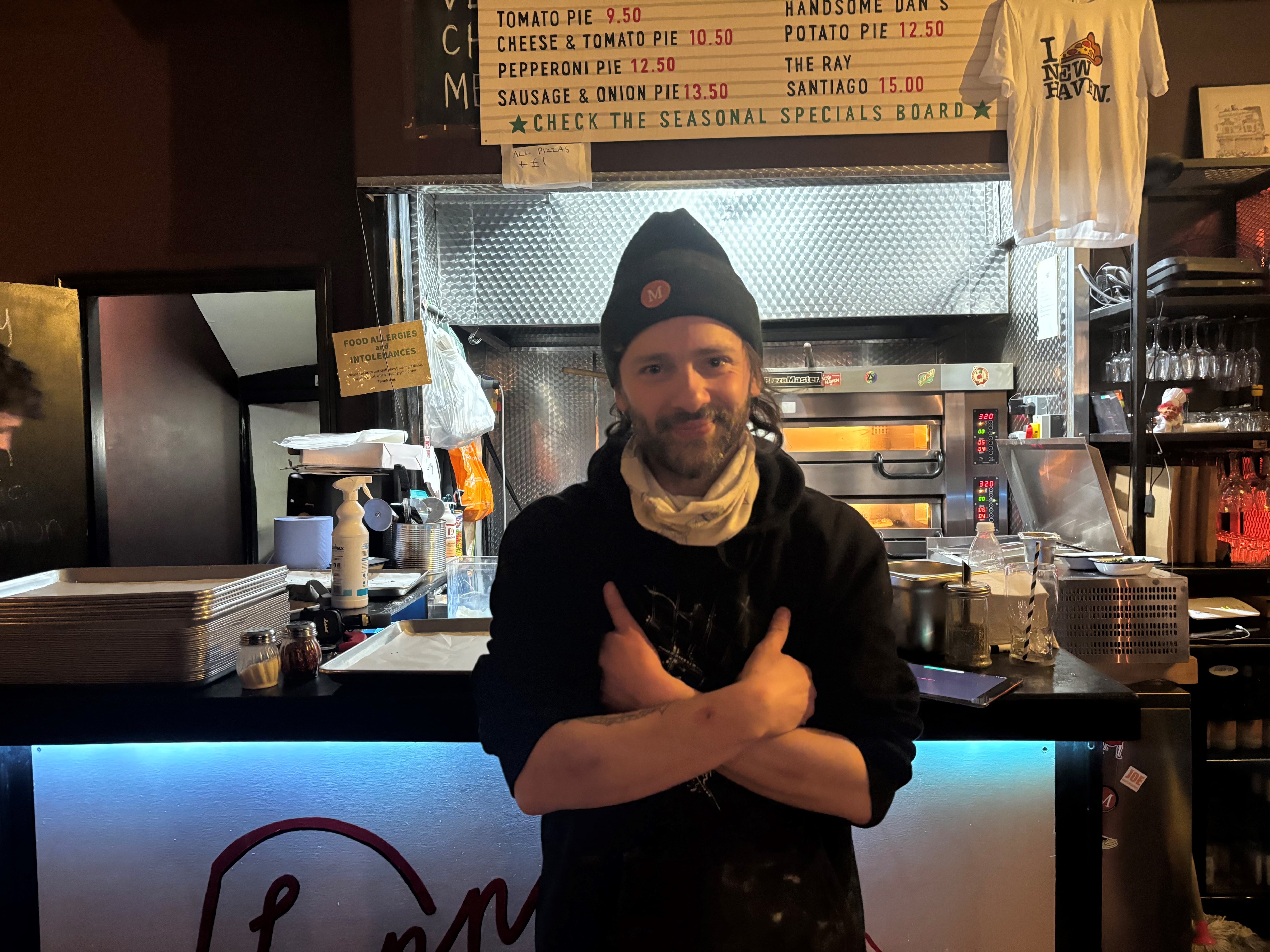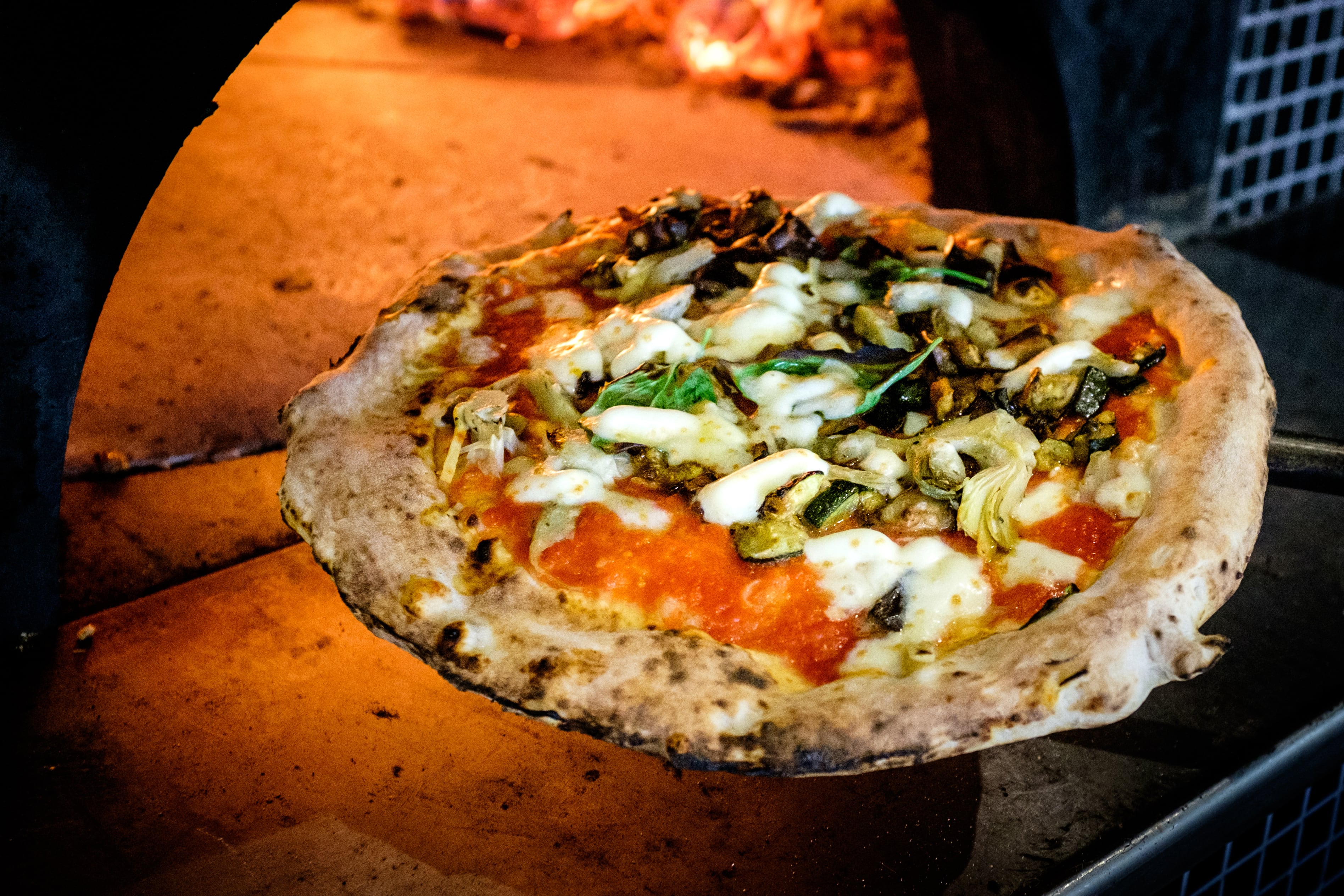New York. New Haven. Sicilian. Roman. Chicago. Detroit. Neapolitan. London? Whether it’s deep-dish, thin and crispy, chewy and charred, or floppy and wet, there’s a style of pizza to suit every occasion and tastes thanks to the burgeoning pizza movement in the UK.
Pizza, of course, isn’t a new phenomenon in the UK but the popularity of certain styles has come in waves. While the first official record of pizza being sold in Britain was in 1934 at a restaurant called The Olivelli (according to the internet) more recent pizza trends have been led by the likes of US brands Pizza Hut and Domino’s, as well as the UK-founded Pizza Express whose more authentic Italian style pizzas created a blueprint for high street restaurants that is still in use today. Then, in 2008, Franco Manca introduced UK diners to a more malleable Neapolitan style to which they had hitherto not been exposed, creating a new pizza category that would become bolstered by new entrants including Pizza Pilgrims and Rudy’s.
While the Neapolitan style of pizza had the UK customer firmly in its thrall - Franco Manca operates around 70 restaurants, Pizza Pilgrims 25 sites and Rudy’s 35 sites - in the past few years different styles of pizza have started to emerge in the UK. Now, in 2025, the market has become awash with players embracing a non-Neapolitan mentality and diners are once again willing to try something different.

Playing an ACE
One such person is Rachel Jones, who has just opened ACE Pizza in Victoria Park. Jones’ pizzas are characterised by blending the chew and char of Neapolitan dough with the structure and foldability of a New York slice - creating what has been dubbed by some a ‘London-style’ pizza. ACE’s pizzas are made with a ‘biga’ dough starter that is slow fermented for over 48 hours for a light, crispy crust and thin base.
Like a number of non-Neapolitan proponents, Jones is not new to the pizza game, having created a pizza menu for Hackney’s The Pembury Tavern back in 2018. Such has been its success that in 2024 she decided to break out on her own, eventually finding her first bricks and mortar site in November of the same year. ACE Pizza opened in the summer serving 12-inch pizzas that include the Honey Pie - made with fior di latte, spicy salami, fennel seeds, guindilla chillies, and chilli honey; Capers on Mare Street - anchovies, Nocellara olives, capers, red onion, fior di latte, and chimichurri; The Capish, featuring vodka sauce, provolone, mozzarella, oregano, pesto swirl, guindilla chillies; and a Clam Pie with clams, oregano, garlic, chilli flakes, fior di latte, pecorino, and lemon.
I’d travelled a lot in the States and Italy and was aware of all these other types of pizza. It felt kind of crazy back then that there weren’t more styles to choose from
Rachel Jones, ACE Pizza
Jones believes the proliferation of non-Neapolitan style pizzas such as hers marks a natural progression in a dining scene that has learnt about different pizza styles through increments. “I grew up in the Midlands eating Domino’s and a lot of people’s perception of pizza at that time was that it was junk food,” she says. “It wasn’t really until the boom in Neapolitan pizza that this changed. When Franco Manco opened in Brixton Market it was something you travelled to. It was another style of pizza, it felt heightened, and the UK needed that to open up the pizza market.”
Jones created her style of pizza as a response to this growth in the Neapolitan style, which she describes as being quite heavy. “When I started back in 2018 there was a lot of Neapolitan pizza about. While I love that type of pizza it is sometimes quite filling, so I developed something very light and easy on the stomach through a long process of fermentation.
“I’d travelled a lot in the States and Italy and was aware of all these other types of pizza. It felt kind of crazy back then that there weren’t more styles to choose from. It comes in waves. There is a generation of people like me who have been exposed to food on TV and had the opportunity to travel and that has opened up the door. Pizza is having a boom in the capital and that’s amazing.”
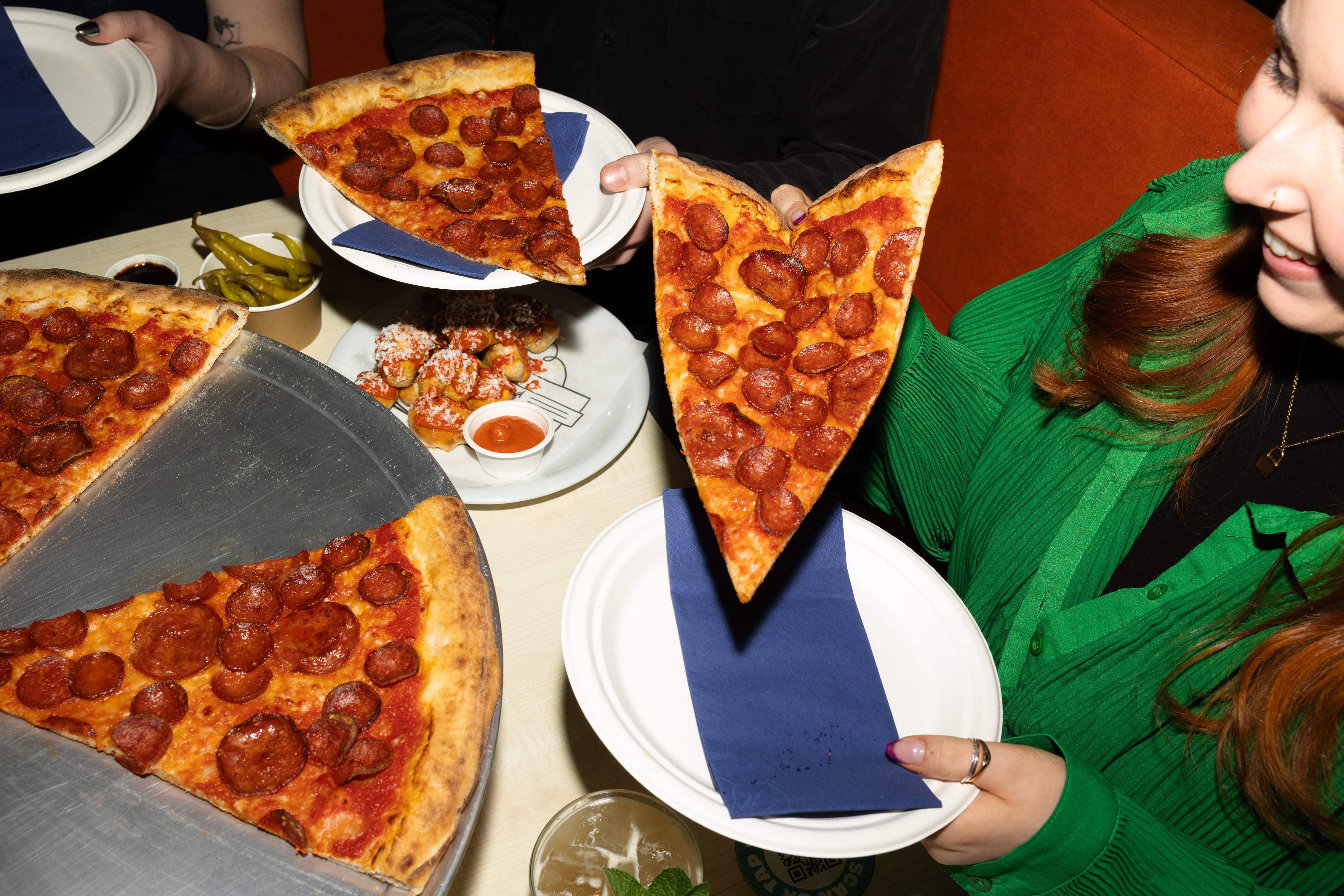
New York via Manchester
Manchester-based Nell’s pizza is another business that has made a name for itself in recent years selling pizza not in the Neapolitan style. Founded by husband-and-wife team Jonny and Charlotte Heyes in 2020, the couple are on the cusp of opening their fifth restaurant, in MediaCity’s quayside Orange Building.
Like Jones, Jonny Heyes says he has always been passionate about making dough, but felt at the time that Neapolitan was not the way to go. Aware of local Neapolitan pizza businesses including Rudy’s and Honest Crust that had made their mark in that area, he decided upon a different style.
“There was an element of self-preservation, I didn’t want to go toe-to-toe with these guys who were amazing at it,” he says. “It felt like there was a lot more out there than just Neapolitan, such as Detroit and New Haven styles, and I was interested in exploring that. It made sense to do something different.”
An English guy making pizza can be authentic to his belief in the style and ingredients. We are Italian but we don’t think that Italians always do things better
Matteo Aloe, Berbere
The couple eventually settled on New York style pizza following a research trip to the US and launched Nell’s with an electric oven cooking pizzas in their Northern Quarter bar Common. “We wanted something that worked with an existing operation and try and harness that New York culture, which we don’t really have over here. Pizza is so hardwired into the culture of New York, you wander around and have a slice, but that mentality doesn’t marry up with how British people operate. We thought that if we were going to do this it needs to sit within a pub. That is still pretty much what we’re doing.”
Indeed, the pub scene has been instrumental in the emergence of new styles of pizza, providing a more risk averse way of getting different pizzas into people’s hands without the confines of a more established - and sometimes more challenging - restaurant setting. As well as ACE Pizza and Nell’s, numerous other pizza players started out in pubs (and continue to do so), including Carl McCluskey’s pizza sensation Crisp Pizza, which trades out of Marylebone pub The Chancellors but will soon be making the move to Mayfair; Neil Rankin, whose Chicago-style pizza brand Little Earthquakes can be found at the Railway Tavern in Dalston; Max Lewis, who serves his New Haven-style ‘apizza’ at the Bedford Tavern in Finsbury Park; and Hannah Drye, whose New York style pizza brand Dough Hands trades from The Spurstowe Arms in Hackney and The Old Nun’s Head in Nunhead. As Drye told Restaurant back in January: “Eating pizza in a restaurant feels dated.”

There are other things at play when trying to understand the explosion in the non-Neapolitan pizza sector. Both Jones and Heyes believe that the growth in different styles of pizza can in part be attributed to it affording chefs greater creativity and freedom while remaining relevant to a core consumer.
“We’re quite lucky here that we’re not really bound by any rules because we haven’t really had a pizza culture here,” says Jones. “It’s a nice melting pot. There’s a movement of chefs trying to do their own thing, who are interested in dough making, ingredients and sourcing and putting something together that is unique.”
“I’m a passionate foodie, and that has sometimes led me to over complicate things and make dishes too expensive,” says Heyes. “Pizza is one of those cuisines that you can get really nerdy about. You can put in lots of time and effort into aspects such as fermentation, sourcing, and endlessly tweak things to be as creative as you want, but people will still understand it.”
Authentically inauthentic
Less dependency on authenticity has also played into this drive for creativity. Heyes says that Nell’s pizzas are New York in style but authentic to Manchester, made using British flour, rapeseed oil rather than olive oil, and local cheeses. “We’re not trying to perfectly ape New York style pizza. It’s authentic to us.”
Jones, meanwhile, describes her pizzas at ACE as a hybrid. “It’s not Neapolitan, it’s not New York; it’s somewhere in the middle. Recently there’s been a band of people making a similar style of pizza. A few people have tried to dub it as a London style pizza but I’m not really sure that London style pizza necessarily is a thing in its own right. It’s a response to inspiration from all over - it’s a bit of New York a bit of Neapolitan, and some Romana in there. It’s slightly thinner, slightly crisper.”
There is a maxim that pizza is recession proof, and I believe that. You can retain a reasonable price and a decent margin
Jonny Heyes, Nell's Pizza
So, what of London pizza? While some people have used it as a shorthand to describe this hybrid style that has emerged, the people behind the pies are less keen on the term. Over at The Bedford, Lewis is not a fan, telling me earlier this year: “We’ve now got this movement of ‘London pizza’ but it just gives all these people who haven’t got their own ideas a way to copy Carl [of Crisp pizza] and a few other people. There is no such thing as London pizza.”
Jones is less bullish on the subject, but also not wedded to the term. “There is some nervousness to using the term London pizza. When we talk about New York or Neapolitan style there’s distinct similarities within that - such as dough styles, the temperature of the bake. London style has more variance to it, it’s chefs putting a spin on things and there’s quite a lot of variation. Because we’re touching on lots of other cultures maybe that adds to why people aren’t keen to say ‘hey, we’ve created a new style’ when it’s not really.”

An Italian approach
It’s not just British people that are tapping into the growth of non-Neapolitan pizza - the Italians are at it too. Take restaurant group Berberè that recently opened its third and fourth locations - by Tottenham Court Road and in Marylebone - joining the group’s other venues in Clapham and Kentish Town and doubling its estate. Berberè was started in Italy by brothers Matteo and Salvatore Aloe in 2010 and initially came to the UK under the auspices of the Radio Alice brand in partnership with restaurant group Azzurri but went it alone in 2020 under its original name.
The pair also describe their sourdough pizza as a kind of hybrid. “In Italy you usually find Neapolitan or Roman style, which is thin and very crispy. Ours is closer to New York style but it’s not New York, I don’t know how to describe it,” says Matteo.
“Sourdough is not Neapolitan, it’s not floppy. We’re not saying that our pizza is the best style, it’s just different. Our pizzas are light and easy to share.”
Despite their Italian heritage, the pair are also less concerned with authenticity within the pizza category. “An English guy making pizza can be authentic to his belief in the style and ingredients. We are Italian but we don’t think that Italians always do things better,” Matteo continues.
Pizza is one of those cuisines that you can get really nerdy about. You can endlessly tweak things to be as creative as you want, but people will still understand it
Jonny Heyes, Nell's Pizza
“It’s important to stay true to your values rather than just authentic ingredients. How my grandfather might have made pizza is not important, it’s more about our approach and to be authentic to your credo than your nationality.”
“For us being authentic is not a domga or a religion,” adds Salvatore, pointing to the restaurant’s name that honours the African spice mix. “Since day one it’s been about different cultures coming together and doing something new. It is fine to have lots of different style and opinions, because pizza has lots of different tastes and I love any kind of pizza.”
Fellow Italian pizza brand Santa Maria is also dipping its toes into new waters. The Neapolitan pizza chain, which has six restaurants across London, is understood to be working on a more experiential pizza concept that will serve a hybrid Neapolitan- and New York-inspired pizza. Due to open by the end of the year, the new concept will be the first time owners Pasquale Chionchio and Angelo Ambrosio have strayed from their Neapolitan roots.
A case of economics
The current economic climate is undoubtedly another factor in the current pizza boom. Rising food costs has forced some chefs to turn to creating cheaper dishes to stop themselves from being priced out of the market, and pizza offers that outlet.
“There is a maxim that pizza is recession proof, and I believe that,” says Nell’s Heyes. “You can retain a reasonable price and a decent margin, and your staff can be really productive as well. You can get a great output from the kitchen. There are lots of one-man bands making some great pizzas at events and doing very well from it.
“From a chef perspective you can put in as much creativity as you want but it won’t necessarily make it more expensive. It ticks a lot of boxes.”
Jones shares this sentiment. “Pizza is for all generations,” she says, describing Ace’s customer base as anyone from people in their twenties to their seventies. “It’s great value. There are not many places in the city where you can get a whole meal for under £15 and it still be exciting.
“There are still lots of nuances with people trying new things. There are few places that offer that experience in a casual setting but make you feel like you’ve had something creative and made uniquely for you at a relatively low price point. It’s still super accessible.”


